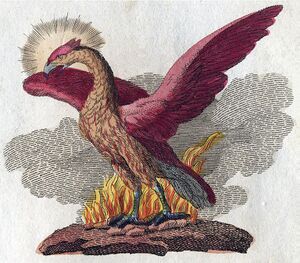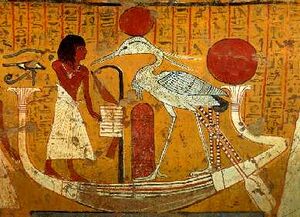Phoenix

The phoenix is a mythical bird that figures in the legends of East and West. It is an ancient symbol of rebirth, rejuvenation and immortality.
One of the earliest accounts of the phoenix describes him as being about the size of an eagle with plumage that is part gold and part crimson. Other accounts say he has brilliant purple feathers with a gold collar.
Legends
The first trace of the phoenix legend appears in about 430 B.C. in Herodotus’ account of Egypt, where he was shown pictures of the bird. In ancient Egypt the phoenix was called a bennu. The bennu was the hieroglyph for the rising sun. The words bennu and phoenix are said to mean variously “palm tree,” purple-red or crimson.
There are several variations of the phoenix legend. The first-century Church Father Clement of Rome once wrote an account of the phoenix, calling it “that wonderful sign which takes place in eastern lands, that is, in Arabia and the countries round about.” This is the legend as he related it:
There is a certain bird which is called a phoenix. This is the only one of its kind. It lives 500 years. And when the time of its dissolution draws near that it must die, it builds itself a nest of frankincense and myrrh and other spices, into which, when the time is fulfilled, it enters and dies.
But as the flesh decays, a certain kind of worm is produced, which, being nourished by the juices of the dead bird, brings forth feathers. Then, when it has acquired strength, it takes up that nest in which are the bones of its parent, and bearing these it passes from the land of Arabia into Egypt, in to the city called Heliopolis. And, in open day, flying in the sight of all men, it places them on the altar of the sun, and having done this hastens back to its former abode. The priests then inspect the registers of the dates and find that it has returned exactly as the five hundredth year was completed.[1]
Later versions of the legend say that when the phoenix is finished making its nest, the rays of the sun ignite the nest. The bird is consumed by the fire. Out of the ashes of the dead phoenix arises the worm that becomes the new phoenix.
Other variations of the story say the bird ignites the fire by fanning its wings.

Esoteric significance in Egypt
According to Professor R. T. Rundle Clark, the real significance of the phoenix (or bennu) has been reduced to a fairy tale by those who were unfamiliar with the inner meaning of Egyptian religion. In reality, the phoenix was the principle of life, the symbol of divine power in manifestation. It was the initiator of a new age and the determiner of destiny.
Clark says that one Egyptian text epitomizes “the appearance of light and life out of the original darkness and chaos as: ‘that breath of life which emerged from the throat of the Benu Bird,’” or phoenix.
The Phoenix embodies the original Logos—the Word or declaration of destiny which mediates between the divine mind and created things. It is essentially an aspect of God, self-created. It is the first and deepest manifestation of the “soul” of the High God. In a sense, when the Phoenix gave out the primeval call, it initiated all cycles of time. As the herald of each new dispensation, it becomes, optimistically, the harbinger of good tidings.
During the Middle Kingdom, the Benu Bird became the symbol for the planet Venus—the morning star which precedes the sun out of the Underworld and is the herald of a new day. In spite of these minor roles, however, the Benu Bird continues to be “he who created himself”—a form of the High God.[2]
Clark says the phoenix also figures in Egyptian religion as
the chief messenger from the inaccessible land of divinity.
The Phoenix came from the far-away world of eternal life, bringing the message of light and life to a world wrapped in the helplessness of the primeval night. Its flight is the width of the world: “over oceans, seas and rivers,” to land, at last, in Heliopolis—the symbolic center of the earth, where it will announce the new age.[3]

Other traditions
The phoenix is known in Arab lore as the anka and in Chinese tradition as the feng-huang. Its arrival was said to portend a great event.
The word phoenix appears in some translations of Job chapter 29 verse 18, which reads: “I shall die in my nest and I shall multiply my days as the phoenix.”
Early Christian writers used the story of the phoenix as an analogy for the resurrection.
To the ancient alchemists, the phoenix represented regeneration, the successful fulfillment of an alchemical process, and the liberated soul.
The phoenix also symbolizes cyclic destruction and re-creation.
On a psychological level, the phoenix has been compared to that element within us that is able to overcome the trials and traumas of life.
Symbol of the soul and reincarnation
The phoenix can also be likened unto the soul. The rebirth of the phoenix out of the fiery flames portends the reincarnation of your soul. The ashes of the phoenix are the ingredients of selfhood. They are the distillation of the former self and the seeds of the new self. The ashes are the positive and negative karma you bring back with you and that portion of soul identity that has been, become endued with God. The ashes of the karmic self have a plus/minus, or yang/yin, polarity. The yang and the yin represent light and darkness.
But the phoenix mystery is more than reincarnation. It is reincarnation as a springboard to self-transcendence. Your soul’s sojourn on earth, lifetime after lifetime, is intended to be an upward spiral, not a treadmill existence.
Hegel accurately described the phoenix as a symbol of self-transcendence when he wrote in his Philosophy of Religion:
Spirit—consuming the envelope of its existence—does not merely pass into another envelope, nor rise rejuvenescent from the ashes of its previous form; it comes forth exalted, glorified, a purer spirit. It certainly makes war upon itself—consumes its own existence. But in this very destruction it works up that existence into a new form, and each successive phase becomes in its turn a material, working on which it exalts itself to a new grade.[4]
See also
Sources
Elizabeth Clare Prophet, “The Phoenix Mystery,” February 17, 1991.
- ↑ Allan Menzies, “The Epistles of Clement,” p. 236–37, in The Ante-Nicene Fathers (Grand Rapids, MI.: W. B. Eerdmans Publishing Company, 19___).
- ↑ R. T. Rundle Clark, Myth and Symbol in Ancient Egypt, pp. 245–46.
- ↑ R. T. Rundle Clark, Myth and Symbol in Ancient Egypt (Grove Press, 1960), p. 247.
- ↑ Joseph Head and S. L. Cranston, comps. and eds., Reincarnation: The Phoenix Fire Mystery (New York: Julian Press/Crown Publishers, 1977), p. 19.
